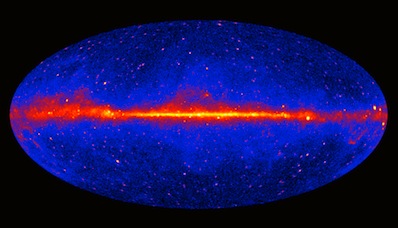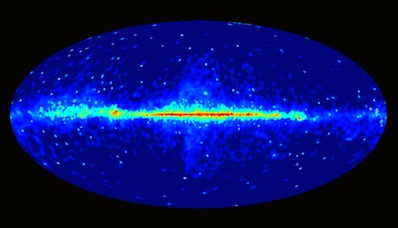



|

|

NASA’s Fermi reveals new portrait of the sky
by Chloe Partridge
for Astronomy Now
Posted: 16 January 2012


A new catalogue of high-energy sources has been published from the Fermi Gamma-ray Space Telescope allowing astronomers to paint a better picture of a previously unexplored region of the night sky.
The telescope, which was launched in June 2008 has, up until now, been exploring the sky at energies between 1-10 Giga-electron volts (GeV). Now, however, Fermi’s Large Area Telescope (LAT), which scans the sky every three hours, has begun to extend its view into higher unexplored energies above 10 GeV. Results announced on 10 January at the 219th meeting of the American Astronomical Society revealed 496 new high energy sources. Over half of these sources are active galaxies with jets that spray out particles at close to the speed of light. However, more than a third of the sources are completely unknown, meaning that they have never previously been detected at any other wavelength.


These all-sky Fermi views show how observable Universe changes as the energy increase from 1 GeV (top) to greater than 10GeV (bottom). The brighter colours indicate brighter gamma-ray sources which in both images is brightest along the plane of our galaxy. Image: NASA/DOE/Fermi LAT Collaboration.
Ten percent of the sources which are already known to astronomers lie within our own Galaxy. Included in these sources is the rapidly rotating neutron star PSRJO534+200 in the Crab Nebula, which rotates 30 times a second, the supernova remnant Cassiopeia A and the not so familiar binary source, LS 5039 (a black hole or a neutron star that circles a high-mass normal star every 3.9 days). “It is sometimes called a microquasar, because it has radio jets that look like miniature versions of the ones seen from the active galaxies of the quasar class,” says Fermi scientist David Thompson of NASA’s Goddard Space Flight Centre.
“The processes that produce such high-energy gamma rays always involves high-energy subatomic particles like electrons or protons colliding with something else - other particles, lower-energy forms of light, or magnetic fields,” continues Thompson. “In the case of the pulsar, the huge electric fields near the neutron star boost electrons to very high energies and those electrons interact with the strong magnetic field in a process called curvature radiation.”
Thompson explains that the supernova remnant is likely powered by the blast wave from the original explosion of the star, producing high-energy protons that collide with the gas around the remnant to produce the gamma rays. "We are not sure what is going on with the binary system," he adds. "The jets of high-energy particles could be colliding with the starlight from the normal star to produce the gamma rays, or strong winds of high-energy particles from the two stars could be colliding with each other.”

The above image shows how NGC 1275 is observable at energies between 1-10 GeV, but as LAT increases it search to energies above 10 Gev NGC 1275 fades from the field of view and a new galaxy, IC 310, emerges. Image: NASA/DOE/Fermi LAT Collaboration and A. Neronov et al.
Fermi’s LAT also reveals how sources can fade and vanish completely when viewed above or below 10 GeV. One example of this is the well-known radio galaxy NGC 1275, which above 10 GeV fades appreciably until it becomes undetectable by Fermi’s LAT. At the other end of the spectrum the radio galaxy IC 310 becomes increasingly more visible as Fermi’s LAT begins to detect the sky at even higher energies.
At these higher energies (above 10GeV) gamma rays are a rare occurrence, with even Fermi’s LAT only detecting one photon above 10 GeV in four months from some sources (but for others the rate is much higher). “Before Fermi, we knew of only four discrete sources above 10 GeV, all of them pulsars,” says Thompson. “With the LAT, we’ve found hundreds, and we’re showing for the first time just how diverse the sky is at these high energies.”
Objects which emit gamma rays at these higher energies must be undergoing extraordinary astrophysical processes, prompting Pascal Fortin at the Ecole Polytechnique’s Laboratoire Leprince-Ringuet in Palaiseau, France, and David Paneque at the Max Planck Institute for Physics, in Munich to publish a Fermi hard source catalogue. The catalogue will serve as an important link between ground-based facilities such as the Atmospheric Cherenkov Telescopes (which also scan the sky for gamma rays) and space based telescopes like Fermi. The Atmospheric Gamma Imaging Cherenkov telescope (MAGIC) in the Canary Islands, the Very Energetic Radiation Imaging Telescope Array System (VERITAS) in Arizona, and the High Energy Stereoscopic System (H.E.S.S.) in Namibia have collectively amassed about 130 gamma-ray sources with energies above 100 GeV. “Our catalogue will have a significant impact on ground-based facilities’ work by pointing them to the most likely places to find gamma-ray sources emitting above 100 GeV,” says Paneque.
According to Fortin, the new catalogue will enable astronomers to compare the behaviour of different sources at above or below 10 GeV for the first time “allowing us to bridge these two energy regimes,” he says.
|

|

|

|
|



